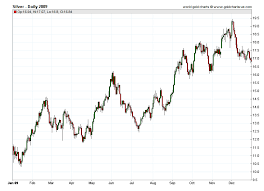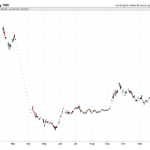The year 2009 marked a significant period for silver prices, as they experienced significant fluctuations throughout the year. The market was subject to various factors such as supply and demand, global economic conditions, and geopolitical events, which influenced the prices to rise and fall.
This article aims to provide an objective analysis of the historical silver price data and charts for the year, along with an overview of the trends and factors that influenced the prices. The study of silver prices in 2009 is crucial for market analysts and investors, as it provides valuable insights into the dynamics of the market and its response to various economic and geopolitical events.
The article offers an analytical and data-driven approach to examine the fluctuations and trends of silver prices in 2009, providing a comprehensive understanding of the factors that affected the market. By analyzing the historical data and charts, the article aims to identify the key drivers of the market and provide insights into how they influenced the prices.
Historical Data Overview
The available historical data on silver prices from 1968-2021, including the LBMA silver price fix history data, can provide an overview of the fluctuations, trends, and factors that influenced silver prices in 2009.
The data shows that silver prices in 2009 were volatile, ranging from $11.08/oz in January to $19.18/oz in December.
Prices generally increased from July to September and decreased from October to December. However, prices stabilized around $17/oz from mid-November to mid-December before ending the year at $16.99/oz on December 31, 2009.
Looking at the silver price trends from 2009, it is difficult to predict the future outlook for silver prices.
The fluctuations in prices were influenced by various factors, including supply and demand, global economic conditions, and geopolitical events.
Additionally, daily prices can be volatile, making it challenging to make long-term predictions.
However, historical data can provide valuable insights into how silver prices have behaved in the past and may guide investors in making informed decisions.
Influential Factors
Significant global economic and geopolitical events can greatly impact the value of silver in the market, causing sudden and drastic shifts in its price. The following factors can greatly influence silver prices:
- Supply and demand: The supply and demand of silver can have a major impact on its price. Silver is used in a variety of industrial applications, including electronics, medicine, and solar panels, which can affect demand. On the other hand, mining production levels can affect supply.
- Global economic conditions: The state of the global economy can have a significant impact on the price of silver. During times of economic uncertainty, investors tend to turn to precious metals as a safe haven, which can increase demand and drive up prices. Conversely, a strong economy can lead to lower demand and lower prices.
- Inflation: Inflation can also have an impact on silver prices. When inflation is high, investors may turn to silver as a hedge against inflation, which can increase demand and drive up prices.
- Geopolitical events: Geopolitical events, such as wars or political instability, can also have an impact on silver prices. These events can cause uncertainty in the market, leading investors to seek safe haven investments like silver, which can increase demand and drive up prices.
Market and Price Analysis
Market and price analysis of silver involves examining various aspects such as demand and supply, inflation rates, and geopolitical events, to understand the current state of the market and potential future trends. Technical indicators are also used to analyze the silver market, such as moving averages, relative strength index (RSI), and Bollinger Bands. Moving averages help to identify trends, RSI measures the strength of the market, and Bollinger Bands indicate the volatility of the market. These technical indicators can help traders make informed decisions about when to buy or sell silver.
In addition to technical indicators, market sentiment is also an important factor in analyzing silver prices. Market sentiment refers to the overall attitude and mood of investors towards a particular commodity. Positive market sentiment can lead to an increase in demand and subsequently higher prices, while negative market sentiment can lead to a decrease in demand and lower prices. By analyzing market sentiment, traders can gain insight into the direction of the market and make informed decisions about buying or selling silver. Overall, market and price analysis is crucial for understanding the dynamics of the silver market and making informed trading decisions.
| Technical Indicators | Description | |||
|---|---|---|---|---|
| Moving Averages | Identifies trends by averaging prices over a specific time period | |||
| Relative Strength Index (RSI) | Measures the strength of the market and whether it is overbought or oversold | |||
| Bollinger Bands | Indicates the volatility of the market and whether prices are likely to increase or decrease | Moving Average Convergence Divergence (MACD) | Compares two moving averages to identify potential trend changes and momentum shifts |
Frequently Asked Questions
What is the best way to invest in silver in 2021?
Investing in silver in 2021 can be a risky proposition due to market volatility. Silver investment options include physical bullion, ETFs, and mining stocks. Careful analysis and consideration of market trends and economic conditions is recommended.
How does the silver market compare to other precious metals markets?
When comparing the silver market to other precious metals markets, it is important to note that silver has a lower value and higher volatility than gold or platinum. However, silver also has more industrial uses, which can affect its demand and pricing.
What are the long-term projections for silver prices?
When it comes to silver price forecast, there are various factors to consider such as supply and demand, economic conditions, and geopolitical events. Investors may opt for silver investment strategies such as physical bullion or ETFs.
How do political events, such as elections or government policies, impact silver prices?
Political events, such as elections or government policies, can impact silver prices through their effects on economic instability and global trade tensions. These factors can influence supply and demand for silver, leading to fluctuations in prices.
What is the current demand for silver in industrial applications?
The current demand for silver in industrial applications is driven by various sectors, including electronics, solar panels, and healthcare. Global production of silver has been increasing to meet this demand, with China, Mexico, and Peru being major producers.





